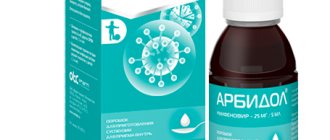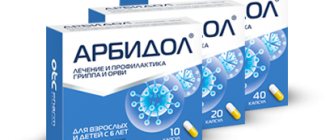Pharmacodynamics and pharmacokinetics
Pharmacodynamics
The active substance is a non-steroidal anti-inflammatory drug with anti-inflammatory and analgesic effects . Penetrates through the cornea and is converted into the active form - amphenac , which inhibits the enzyme necessary for the production of prostaglandins. The use of the drug reduces pain and swelling of the eye tissues without affecting intraocular pressure.
Pharmacokinetics
Rapidly absorbed when applied topically. After daily use, low concentrations of the active substance are detected in the blood after 2 hours. Cmax of nepafenac in the aqueous humor of the eye is observed after 1 hour. The active substance has a high affinity for albumin and binding to them is 99%. Under the influence of enzymes, it undergoes hydrolysis to amfenac, which subsequently forms conjugates with glucuronic acid. In studies after oral administration, it was excreted by the kidneys (about 85%) and through the intestines (6%).
Nevanac®
Mechanism of action
Nepafenac is a precursor to the active form of non-steroidal drugs with anti-inflammatory and analgesic effects. When applied topically, nepafenac penetrates the cornea of the eye, where, with the help of hydrolases, it is converted in the eye tissues into amfenac, the active form. Amfenac inhibits the action of prostaglandin H-synthase (cyclooxygenase), an enzyme necessary for the production of prostaglandin.
Secondary pharmacological effect
In rabbits, nepafenac reduces the permeability of the blood-retinal barrier, simultaneously with inhibition of PGE2 synthesis. In ex
vivo
, a single dose of topical nepafenac has been confirmed to suppress prostaglandin synthesis in the iris/ciliary body (85-95%) and retina/choroid (55%) for up to 6 hours and 4 hours, respectively.
Pharmacodynamic properties
Most hydrolytic transformations occur in the retina/choroid, but also in the iris/ciliary body and cornea, depending on the degree of vascularization of the tissue.
The results of clinical studies indicate that Nevanac® does not have a significant effect on intraocular pressure.
Clinical efficacy and safety
Prevention and treatment of pain and inflammation in the postoperative period of cataract extraction
Three pivotal studies were conducted to evaluate the effectiveness and safety of Nevanac® when administered three times daily compared with placebo and/or ketorolac trometamol in the prevention and treatment of pain and inflammation in postoperative cataract extraction patients. In these studies, study drug administration began 1 day before surgery, continued on the day of surgery, and continued until 2-4 weeks postoperatively. Additionally, almost all patients received prophylactic antibiotic treatment, according to clinical practice at each study site.
In two double-blind, randomized, placebo-controlled studies, patients receiving Nevanac® had significantly less inflammation (cells and aqueous opalescence) from the early postoperative period to the end of treatment than patients receiving placebo.
In one double-blind, randomized, placebo-controlled, active-controlled study, patients receiving Nevanac® had significantly less inflammation than patients receiving placebo. In addition, Nevanac® was not inferior to ketorolac 5 mg/ml in reducing inflammation and pain in the eyes and turned out to be significantly more convenient when instilled.
In the Nevanak® drug group, cases of absence of eye pain in the postoperative period of cataract extraction were recorded in a significantly higher percentage of patients than in the placebo group.
Reducing the risk of developing macular edema in patients with diabetes mellitus in the postoperative period of cataract extraction
Four studies were conducted to evaluate the effectiveness and safety of Nevanak® when used for the prevention of postoperative macular edema in connection with cataract extraction surgery (two among patients with diabetes mellitus and two among patients without diabetes mellitus). In these studies, study drug administration began 1 day before surgery, continued on the day of surgery, and up to 90 days postoperatively.
In one double-blind, randomized, placebo-controlled study conducted in patients with diabetic retinopathy, macular edema developed in a significantly higher percentage of patients in the placebo group (16.7%) compared with the Nevanac® group (3.2%). A higher proportion of patients receiving placebo experienced a decrease in best-corrected visual acuity of more than 5 letters from day 7 to day 90 (or premature discontinuation in the placebo group) (11.5%) compared with patients receiving nepafenac (5, 6%). A 15-letter improvement in best-corrected visual acuity was observed in a greater proportion of patients taking Nevanac® compared to patients taking placebo, 56.8% vs. 41.9%, respectively, p=0.019.
Side effects
Systemic side effects:
- headache;
- nausea, vomiting,
- increased blood pressure;
- sinusitis;
- dry mouth.
Local reactions:
- punctate keratitis;
- conjunctival hyperemia and dryness;
- itchy eyes;
- blurred vision;
- Pain in the eyes;
- iritis , keratitis;
- irritation and discharge from the eyes;
- photophobia;
- increased lacrimation.
If signs of corneal damage (corneal clouding, epithelial defect ), the drug should be discontinued, as this poses a risk of vision loss.
Nevanac, 1 piece, 5 ml, 0.1%, eye drops
General Security Profile
In clinical studies involving 2314 patients using Nevanac® 1 mg/ml, the most common adverse events were punctate keratitis, foreign body sensation in the eye, and crusting of the eyelid margins, which were observed in 0.4–0.2% of patients. The adverse events presented below are listed according to the damage to organs and organ systems and the frequency of occurrence. The frequency of occurrence is determined as follows: very often (≥1/10); often (≥1/100 and <1/10); uncommon (≥1/1000 and <1/100); rare (≥1/10,000 and <1/1000); very rare (<1/10000); frequency unknown (cannot be determined from available data). Within each frequency group, adverse events are presented in decreasing order of severity.
Information about adverse events was obtained from clinical studies and during post-marketing surveillance of the drug.
From the immune system:
rarely - hypersensitivity.
From the nervous system:
rarely - dizziness; frequency unknown - headache.
From the side of the organ of vision:
frequency unknown - keratitis, punctate keratitis, corneal epithelial defect, foreign body sensation in the eyes, crust formation on the edges of the eyelids, eyelid disorders; rarely - iritis, ciliochoroidal detachment, deposits in the cornea, eye pain, eye discomfort, photophobia, dry eye syndrome, blepharitis, itching in the eyes, discharge from the eyes, allergic conjunctivitis, increased lacrimation, conjunctival hyperemia; frequency unknown - corneal perforation, delayed corneal healing, corneal opacities, corneal scar, decreased visual acuity, eye irritation, eye swelling, ulcerative keratitis, corneal thinning, blurred vision.
From the side of blood vessels:
frequency unknown - increased blood pressure.
From the respiratory system, chest and mediastinal organs:
often - sinusitis.
From the gastrointestinal tract:
uncommon - dry mouth; rarely - nausea; frequency unknown - vomiting.
For the skin and subcutaneous tissues:
rarely - skin extensibility (dermatochalasis), allergic dermatitis.
Patients with diabetes mellitus
In two clinical studies involving 209 patients, patients with diabetes were treated with Nevanac® for 60 days or more to prevent macular edema during the postoperative period of cataract extraction. The most common adverse reaction was punctate keratitis, reported in 3% of patients (frequency category: common). Other reported cases were corneal epithelial defect and allergic dermatitis, reported in 1 and 0.5% of patients, respectively (frequency category: uncommon).
Description of selected adverse events
Long-term clinical experience with Nevanac® for the prevention of macular edema in connection with cataract surgery in patients with diabetes is limited. Adverse effects from the organ of vision in patients with diabetes may occur more often than in the general population (see “Special Instructions”).
In patients with signs of damage to the corneal epithelium, including corneal perforation, the use of Nevanak® should be stopped immediately and the condition of the cornea should also be carefully monitored (see "Special Instructions").
Cases of corneal epithelial defect/corneal disorder have been reported during post-marketing surveillance of Nevanac®. The severity of these cases ranges from mild effects on the integrity of the corneal epithelium to more severe events in which surgery and/or additional medications were required to restore clear vision.
Post-marketing experience with topical NSAIDs suggests that patients with complex eye surgery, corneal denervation, corneal epithelial defects, diabetes mellitus, ocular surface disease (eg, dry eye syndrome), rheumatoid arthritis, or repeated eye surgery within a over a short period of time have an increased risk of developing adverse reactions from the cornea, which may pose a threat to vision.
When prescribing Nevanac® to patients with diabetes after cataract surgery to prevent macular edema, the presence of any additional risk factor requires re-evaluation of the expected benefit/risk ratio and more intensive monitoring of the patient.
Pediatric population
The safety and effectiveness of Nevanac® in children and adolescents has not been established.
Nevanak, instructions for use (Method and dosage)
Drops are applied topically, 1 drop per eye 3 times a day. Treatment begins 1 day before cataract and continues for 2 weeks after surgery. The drug is additionally used 30 minutes before surgery. Shake the bottle before use. During treatment it is necessary to avoid exposure to the sun.
Long-term use increases the risk of adverse reactions from the cornea. The preservative content in the preparation causes irritation and discoloration of contact lenses. Wearing contact lenses during treatment is not recommended. The drug is used with caution in patients with a history bleeding
Nevanak
Use during pregnancy and breastfeeding
Use during pregnancy and lactation is not recommended.
If it is necessary to prescribe during lactation, breastfeeding is recommended to be stopped for the duration of treatment. Animal testing revealed reproductive toxicity. In a study of the effects of nepafenac on the reproductive organs of rats, administration of toxic doses >10 mg/kg led to dystocia, an increase in the number of spontaneous abortions at the post-implantation stage, a decrease in body weight and growth of embryos, and a decrease in embryo survival. In pregnant rabbits, taking low-toxic doses of 30 mg/kg led to an increase in developmental defects in the offspring.
Use in children
Contraindicated in children under 18 years of age.
special instructions
Patients should avoid exposure to sunlight.
The use of topical NSAIDs may lead to the development of keratitis. In some susceptible patients, long-term use of topical nonsteroidal anti-inflammatory drugs may cause epithelial cell rupture, corneal thinning, corneal erosion, corneal ulceration, or corneal perforation. These side effects may pose a risk of vision loss. Patients with signs of rupture of corneal epithelial cells should immediately stop using the drug and be monitored to monitor the condition of the cornea.
Use of topical NSAIDs may slow or delay the healing process. Topical corticosteroids are also known to slow or delay healing. Concomitant use of topical NSAIDs and topical corticosteroids may slow or delay the healing process.
Experience with topical NSAIDs suggests that patients with complications from ophthalmic surgery, corneal denervation, corneal epithelial defects, diabetes mellitus, superficial ocular disease (eg, dry eye syndrome), rheumatoid arthritis, or repeated surgeries performed within a short period of time time, may have an increased risk of developing adverse reactions from the cornea, which may pose a risk of vision loss. Topical NSAIDs should be used with caution when treating these patients. Long-term use may increase the risk and severity of corneal adverse reactions.
The use of topical NSAIDs in combination with eye surgery may cause severe bleeding in the ocular tissues (including hyphema). Nevanac should be used with caution in patients with a history of bleeding or if patients are receiving other medications that may increase blood clotting time.
There are no data on the simultaneous use of prostaglandin analogues and Nevanac. Given their mechanisms of action, simultaneous use is not recommended.
This product contains the preservative benzalkonium chloride, which may cause eye irritation and discoloration of soft contact lenses. Additionally, wearing contact lenses is not recommended during the postoperative period following cataract surgery. It is not recommended to use contact lenses during treatment with Nevanac.
Studies have shown that benzalkonium chloride, which is contained in Nevanac, can cause punctate keratitis and/or toxic ulcerative keratitis. Therefore, with frequent or long-term use of the drug, careful medical monitoring of the patient’s condition is necessary.
The use of topical NSAIDs may prevent timely recognition of signs of acute eye infection, because they do not have any antimicrobial properties. In case of development of an eye infection, the use of topical non-steroidal anti-inflammatory drugs simultaneously with antibacterial agents should be carried out with precautions.
Cross Sensitivity
When using nepafenac, there is a possibility of developing cross-sensitivity to acetylsalicylic acid, fennacetic acid derivatives, as well as other NSAIDs.
Do not touch the tip of the dropper bottle to any surface to avoid contamination of the bottle and its contents.
The bottle must be closed after each use.
Impact on the ability to drive vehicles and operate machinery
After using the drug, a temporary decrease in the clarity of visual perception is possible, and until it is restored, it is not recommended to drive a car or engage in activities that require increased attention and reaction.
Interaction
Studies have shown that the drug does not inhibit the activity of cytochrome P450, therefore there is no interaction with drugs that transform with the involvement of cytochrome P450. The simultaneous use of this drug and Prostaglandin or its analogues is not recommended, since there is no data on their simultaneous use. When used in combination with other drugs, it is necessary to maintain an interval of 5 minutes between instillations.
Nevanaka price, where to buy
You can buy Nevanak in many pharmacies in Moscow and other Russian cities. The price varies between 517 - 539 rubles per package.
- Online pharmacies in RussiaRussia
- Online pharmacies in UkraineUkraine
- Online pharmacies in KazakhstanKazakhstan
Pharmacy Dialogue
- Nevanak (cap. vial 5 ml) Alcon SA
RUB 683 order - Nevanak (cap. cap. 0.1% vial 5 ml) S.A. Alkon-Kuvrer n.v.
RUR 764 order
show more
Pharmacy24
- Nevanak 1 mg/ml 5 ml eye drops
281 UAH.order
PaniPharmacy
- Nevanac liquid Nevanac h/c 1 mg/ml 5 ml No. 1 Belgium, Alcon-Couvreur
297 UAH order
show more



